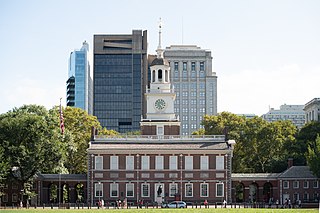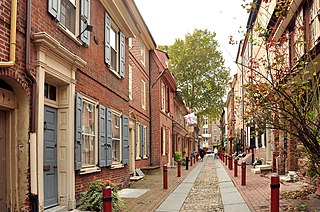Related Research Articles
The National Register of Historic Places (NRHP) is the United States federal government's official list of districts, sites, buildings, structures, and objects deemed worthy of preservation for their historical significance or "great artistic value". A property listed in the National Register, or located within a National Register Historic District, may qualify for tax incentives derived from the total value of expenses incurred in preserving the property.

The National Trust for Historic Preservation is a privately funded, nonprofit organization based in Washington, D.C. that works in the field of historic preservation in the United States. The member-supported organization was founded in 1949 by congressional charter to support the preservation of America’s diverse historic buildings, neighborhoods, and heritage through its programs, resources, and advocacy.

A National Historic Landmark (NHL) is a building, district, object, site, or structure that is officially recognized by the United States government for its outstanding historical significance. Only some 2,500 (~3%) of over 90,000 places listed on the country's National Register of Historic Places are recognized as National Historic Landmarks.

The New York City Landmarks Preservation Commission (LPC) is the New York City agency charged with administering the city's Landmarks Preservation Law. The LPC is responsible for protecting New York City's architecturally, historically, and culturally significant buildings and sites by granting them landmark or historic district status, and regulating them after designation. It is the largest municipal preservation agency in the nation. As of July 1, 2020, the LPC has designated more than 37,000 landmark properties in all five boroughs. Most of these are concentrated in historic districts, although there are over a thousand individual landmarks, as well as numerous interior and scenic landmarks.

The National Historic Preservation Act is legislation intended to preserve historic and archaeological sites in the United States of America. The act created the National Register of Historic Places, the list of National Historic Landmarks, and the State Historic Preservation Offices.

Historic districts in the United States are designated historic districts recognizing a group of buildings, properties, or sites by one of several entities on different levels as historically or architecturally significant. Buildings, structures, objects, and sites within a historic district are normally divided into two categories, contributing and non-contributing. Districts vary greatly in size: some have hundreds of structures, while others have just a few.

In the law regulating historic districts in the United States, a contributing property or contributing resource is any building, object, or structure which adds to the historical integrity or architectural qualities that make the historic district significant. Government agencies, at the state, national, and local level in the United States, have differing definitions of what constitutes a contributing property but there are common characteristics. Local laws often regulate the changes that can be made to contributing structures within designated historic districts. The first local ordinances dealing with the alteration of buildings within historic districts was passed in Charleston, South Carolina in 1931.

The U.S. National Register of Historic Places (NRHP) classifies its listings by various types of properties. Listed properties generally fall into one of five categories, though there are special considerations for other types of properties which do not fit into these five broad categories or fit into more specialized subcategories. The five general categories for NRHP properties are: building, district, object, site, and structure.
The Commission on Chicago Landmarks, established in 1968 by a Chicago City Ordinance, is composed of nine members appointed by the Mayor and the Chicago City Council. It is responsible for presenting recommendations of individual buildings, sites, objects, or entire districts to be designated as Chicago Landmarks, therefore providing legal protections. The commission is staffed by the Landmarks Division of the Chicago Department of Planning and Development.

Los Angeles Historic-Cultural Monuments are sites which have been designated by the Los Angeles, California, Cultural Heritage Commission as worthy of preservation based on architectural, historic and cultural criteria.

Third Church of Christ, Scientist, established in 1918, is a Christian Science church in downtown Washington, D.C. From 1971 to 2014, the church was located in a controversial building at 16th and I Street NW. Considered a significant work of "Brutalist" church architecture by some critics, the building was considered unsatisfactory by members of the Church's congregation, which shrank over the years. In 2007, the church applied for a demolition permit for the building to permit sale and redevelopment of the site, with plans to relocate to a more suitable structure. A 1991 application for landmark status for the building, filed to forestall a demolition threat then, was subsequently approved. After a lawsuit and hearings, the District of Columbia issued a demolition permit in May 2009, and the building was demolished in 2014. In 2015, Third Church merged with First Church of Christ, Scientist. The congregation continues as First Church and conducts its activities in a portion of the new building.

3400 International Drive is an office complex in the North Cleveland Park neighborhood of Washington, D.C. by the Van Ness metro station.
The City of Seattle Landmarks Preservation Board is responsible for designating and preserving structures of historical importance in Seattle, Washington. The board recommends actions to the Seattle City Council, which fashions these into city ordinances with the force of law. The board is part of the city's Department of Neighborhoods.

The Georgetown Car Barn, historically known as the Capital Traction Company Union Station, is a building in the Georgetown neighborhood of Washington, D.C., in the United States. Designed by the architect Waddy Butler Wood, it was built between 1895 and 1897 by the Capital Traction Company as a union terminal for several Washington and Virginia streetcar lines. The adjacent Exorcist steps, later named after their appearance in William Friedkin's 1973 horror film The Exorcist, were built during the initial construction to connect M Street with Prospect Street.

Baltimore City Landmark is a historic property designation made by the city of Baltimore, Maryland. Nominations are reviewed by the city's Commission for Historical & Architectural Preservation (CHAP) and planning board, and are passed by Baltimore City Council. The landmarks program was created in 1971.
References
- ↑ "Historic Preservation Review Board". District of Columbia Office of Planning. Archived from the original on August 23, 2017. Retrieved November 2, 2019.
- ↑ "About the Historic Preservation Review Board". District of Columbia Office of Planning. Archived from the original on December 12, 2018. Retrieved November 2, 2019.
- ↑ "About Historic Landmarks and Historic Districts". District of Columbia Office of Planning. Archived from the original on August 13, 2019. Retrieved November 2, 2019.
- ↑ "Criteria for Designation in the DC Inventory". District of Columbia Office of Planning. Archived from the original on December 22, 2016. Retrieved November 2, 2019.
- ↑ "Criteria for Designating Historic Properties in the District of Columbia" (PDF). District of Columbia Office of Planning. Archived (PDF) from the original on February 1, 2017. Retrieved November 2, 2019.